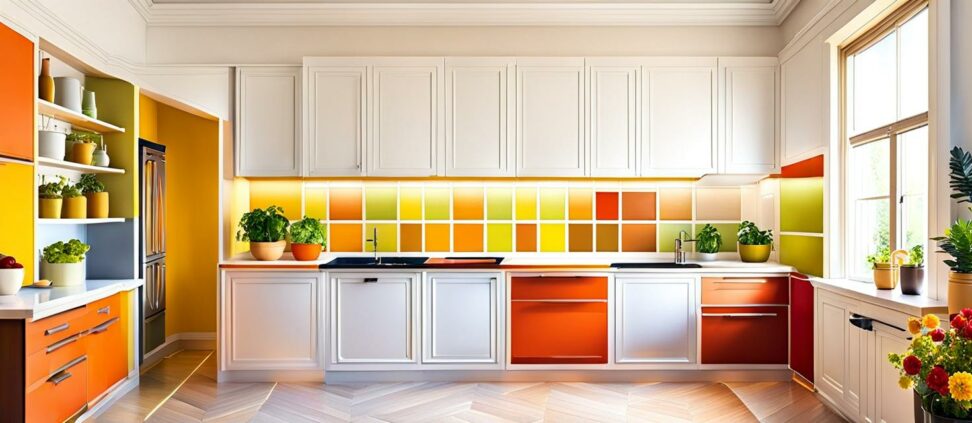The Ultimate Guide to Painting Your Kitchen Walls Like a Pro
If your kitchen walls are looking dingy or dated, it may be time for a fresh coat of paint. Painting the kitchen by yourself can totally transform the space. But with so many paint options and steps involved, it can seem daunting to DIY novices. This comprehensive guide covers everything you need to know to paint your kitchen walls professionally.
Properly preparing the walls and choosing the right paint will lead to a smooth, durable finish able to withstand moisture, grease splatters, and frequent scrubbing. We'll walk through selecting primers and paint sheens, prepping the walls, application techniques, and maintenance tips. Follow this advice to get flawless, long-lasting results.
Selecting the Right Paint Finish
With all the choices at the hardware store, picking the optimal primer and paint for your kitchen can be tricky. Keep these tips in mind.

Primers
Priming before painting is a must for kitchen walls. Primers seal porous surfaces so the topcoat of paint adheres smoothly and evenly. For kitchens, look for primers formulated to block stains from food, grease, and pen marks. Water-based latex primers work well for most surfaces. Apply primer to raw drywall, previously unpainted walls, and over oil-based paints before repainting.
Paint Types
Latex vs. Oil-Based
For painting kitchen walls, water-based latex or acrylic paints are the best choice. Latex paints provide good durability and allow for easy cleanup with water. Oil-based paints take longer to dry and emit strong fumes.
Paint Sheens
The sheen or gloss level impacts how shiny or matte a finish appears. It also affects durability and ease of cleaning.
Flat/Matte - Completely non-reflective. Hides imperfections well but prone to stains and marks. Hard to clean.
Eggshell - Soft, velvety appearance. Washes easily but prone to scuffing.
Satin - Low to medium shine. Stain resistant. Stands up well to cleaning.
Semi-Gloss - Very shiny and reflective. Most durable and scrub-able. Good for high traffic zones.
For kitchen walls, satin and semi-gloss sheens are best. They provide a scrubbable finish that resists moisture, grease, and dirt. Satin offers a smooth, Pearl-like appearance, while semi-gloss has a shiny, slick look.
Prep Steps Before Painting
Preparing your kitchen walls correctly before painting is 90% of the work. Proper prep leads to better adhesion and a smooth, lasting finish.
Cleaning Surfaces
Kitchen walls attract dirt, grease, and grime. Thoroughly wash down all surfaces using a degreasing cleaner or TSP substitute. This removes built-up grease that could cause peeling. Fill any holes or imperfections with spackle and let dry completely before sanding smooth.
Sanding and Removing Gloss
Lightly sand walls to improve paint adhesion. This roughs up glossy areas so the paint can grip better. Wipe away all dust with a dry cloth or tack cloth.
Spot Priming as Needed
Spot prime unpainted patches or repaired areas before painting the entire wall. Also prime heavily stained areas like behind the stove or over grease splatters. Use an oil-based stain-blocking primer for best results.
Paint Application Tips
"Cutting in" along edges and rolling the main fields requires some technique. Here are some tips:
- Use high-quality mini rollers and angled cutting brushes.
- "Cut in" the edges and corners first, then immediately roll the main wall.
- Apply paint in approximately 3x3 foot sections.
- Roll up and down in "W" and "M" patterns, overlapping slightly.
- Work in manageable sections to avoid lap marks before paint dries.
- Two coats are usually needed for full coverage and even sheen.
- Let the first coat dry fully before adding the second (usually 4-6 hours).
Caring for Painted Kitchen Walls
The paint will take around 30 days to fully cure and harden. Avoid scrubbing or cleaning with harsh chemicals during this time. When washing walls:
- Use a soft sponge or microfiber cloth with warm, soapy water.
- Blot gently instead of vigorously scrubbing.
- Immediately wipe up any spills or splatters.
- Touch up scrapes or nicks quickly to avoid moisture damage.
Mistakes to Avoid
Steer clear of these common missteps when prepping and painting kitchen walls:
- Inadequate cleaning and sanding of surfaces
- Using low-quality primer not suited for kitchens
- Choosing the wrong sheen like flat or eggshell
- Applying paint too thickly or thinning it excessively
- Not allowing proper dry times between coats
- Using harsh cleaners or scrubbing paint too soon
With the right prep work and paint choices, you can give your kitchen walls a fresh, updated look with professional quality results. Satin or semi-gloss latex paints provide a durable, scrubbable finish that will keep your kitchen walls looking cleaner for longer.
Pay close attention to thoroughly cleaning walls, sanding, and spot priming before painting. Apply two coats using proper cutting in and rolling techniques. Follow the tips in this guide to paint your kitchen walls like an expert.